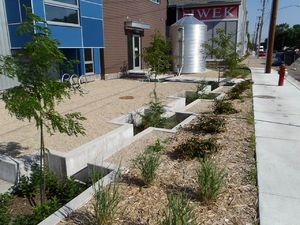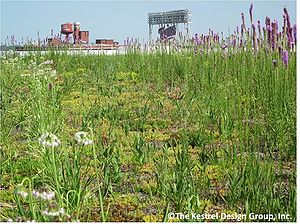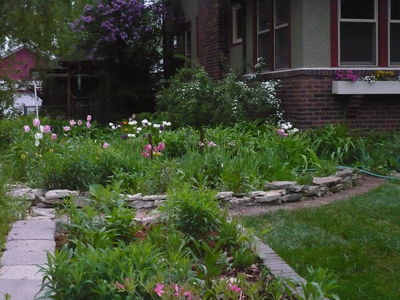
Multiple benefits of green infrastructure and role of green infrastructure in sustainability and ecosystem services
Human activities can negatively impact hydrologic and chemical cycles, pollute air and water, degrade soil, and reduce biodiversity. Failure to maintain basic ecosystem functions places humans at risk because of our dependence on these functions. As human populations and resource consumption increase, it becomes even more important to preserve basic ecosystem functions. Sustainability is the principle and practice of creating and maintaining the conditions under which humans and nature can exist in productive harmony to support present and future generations. Green infrastructure is one tool or approach to creating sustainable urban environments.
Contents
What are ecosystem services?
The natural environment provides basic services required for humans and all life to survive. These ecosystem services can be divided into four basic categories or types.
- Supporting services are basic services needed to support all other ecosystem services. An example is primary production, which is the production of organic compounds from carbon dioxide. Plants and algae are largely responsible for primary production. Other examples of supporting services are nutrient cycling and soil formation. These services provide basic materials needed by organisms.
- Provisioning services are products obtained from ecosystems, such as food, minerals, lumber, energy, medicines, and water. It is these services that humans typically rely on for economic purposes and to improve quality of life. The concern is that in utilizing provisioning services we degrade other services.
- Regulating services ensure the continued availability of other ecosystem services. Examples include purification of air and water, waste composition, and climate regulation. Humans often stress these systems. for example, introducing too much phosphorus into a lake impairs the ability of the lake to regulate the growth of algae.
- Cultural services are unique to humans. Though not essential to survival, they are important for human well-being and development. Examples include the use of ecosystems for recreation, scientific development, and education.
Numerous studies attempt to place a dollar value on ecosystem services, though the value of these services is infinite in the sense that human survival depends on them. Costanza et al. (2014) place an annual value of 125 to 145 trillion dollars on ecosystem services, which is more than double the global GDP. The authors also estimate an annual loss of 4.3 to 20.2 trillion dollars, underscoring the negative impact humans are having on basic ecosystem functions necessary for our well-being.
Sustainability
A central tenet of sustainability is that we must preserve ecosystem services necessary for humans to survive and prosper. In 1987, a World Commission on Environment and Development report (UN, 1987) defined sustainable development as "development that meets the needs of the present without compromising the ability of future generations to meet their own needs".
A challenge is incorporating basic sustainability concepts into social and economic systems. These systems historically have not placed proper value on ecosystem services, resulting in the degradation of these services. For example, stormwater in urban areas was traditionally viewed as something that negatively impacted humans, primarily through flooding. Traditional stormwater systems were designed to discharge stormwater to the nearest receiving water as quickly as possibly. The result was a dramatic change in urban hydrology, increased flooding downstream, reduced water quality, and loss of habitat. Sustainability stresses using stormwater as a resource. Using stormwater as a resource restores some natural resource function and provides economic and social benefit. Sustainable practices achieve a balance between environmental, social, and economic factors.
Relationship of green infrastructure to ecosystem services and sustainability
Green infrastructure is an approach to managing urban wet weather impacts that mimics, restores, or maintains natural hydrology. Green infrastructure includes a wide array of practices, including infiltrating, evapotranspiring, or harvesting and using stormwater. On a regional scale, green infrastructure is the preservation or restoration of natural landscape features, such as forests, floodplains and wetlands. On the local scale, green infrastructure consists of site and neighborhood-specific practices, such as bioretention, trees, green roofs, permeable pavements and cisterns. Regional and local practices are coupled with policies such as infill and redevelopment that reduce overall imperviousness in a watershed.
Green infrastructure is an important component of sustainable urban communities. Green infrastructure helps maintain ecosystem services in the following ways.
- Air quality regulation: Potential of ecosystems to capture and remove air pollutants in the lower atmosphere.
- Erosion protection: Potential of ecosystems to retain soil and to prevent erosion and landslides.
- Water flow regulation: Influence ecosystems have on the timing and magnitude of water runoff and aquifer recharge, particularly in terms of water storage potential.
- Pollination: Potential of animal vectors (bees being the dominant taxon) to transport pollen between flower parts
- Maintenance of soil structure and quality: The role ecosystems play in sustaining the soil's biological activity, physical structure, composition, diversity and productivity.
- Water purification: The role of biota in biochemical and physicochemical processes involved in the removal of wastes and pollutants from the aquatic environment
- Climate regulation: The influence ecosystems have on global climate by regulating greenhouse and climate active gases (notably carbon dioxide) from the atmosphere.
The following section provides detailed information on each of these.
References for this section
- http://www.sciencedirect.com/science/article/pii/S1462901115300356
- https://oup.silverchair-cdn.com/oup/backfile/Content_public/Journal/aob/118/3/10.1093_aob_mcw129/4/mcw129.pdf?Expires=1499202007&Signature=MKFboo4SNPRu0nLQ2T3KbbKeT53lPKiVNmV6dJv~C~WNJHNIiqIn8ZyBkKZutcXqBFSGIov2Lld8BEAn8COgiq3R82nuI7rsXD-WiIByGOHboHad4mtPVGoWcLs2Jmb0ZbN-B~YuPx5icDJtxhMDOX4weYRcNbxF9pGXXGecH3CbDE~Kr8hDoPfz8my2du5cO~uOFQ-6NY6w2TwzkxwKyhbVcwEX5w8DO1tUabEJyLwzFVhA1SB4pveBMw3z4zUPQjuEJDeCj07TkvpWYFwIwVA3~IR9tDFBPN942muscqFGUy3mB~Yexi7ANEpPJMdSgb-l5P09h7zxdbdsFF2-Kw__&Key-Pair-Id=APKAIUCZBIA4LVPAVW3Q
- http://www.symbioticcities.net/index.cfm?id=47825
- https://www.google.com/url?sa=t&rct=j&q=&esrc=s&source=web&cd=4&cad=rja&uact=8&ved=0ahUKEwj7-N214-3UAhVo4IMKHSDTDY4QFghBMAM&url=http%3A%2F%2Fwww.mdpi.com%2F2071-1050%2F9%2F2%2F198%2Fpdf&usg=AFQjCNGf9hCHdD4tZ02vakFBU0VsHE6xcQ
- https://www.epa.gov/sites/production/files/2014-10/documents/green-infrastructure.pdf
- https://scholar.google.com/scholar?q=green+infrastructure+ecosystem+services&hl=en&as_sdt=0&as_vis=1&oi=scholart&sa=X&ved=0ahUKEwj7-N214-3UAhVo4IMKHSDTDY4QgQMIIjAA
- http://ec.europa.eu/environment/nature/ecosystems/docs/Green_Infrastructure.pdf
- http://www.symbioticcities.net/index.cfm?id=47825
- http://www.cnt.org/sites/default/files/publications/CNT_Value-of-Green-Infrastructure.pdf
- https://www.epa.gov/sites/production/files/2015-10/documents/cnt-lancaster-report-508_1.pdf
- http://www.sciencedirect.com/science/article/pii/S0269749101002147
- http://scholar.google.com/scholar?q=carbon+sequestration+by+trees&hl=en&as_sdt=0&as_vis=1&oi=scholart&sa=X&ved=0ahUKEwiZ8YWAsP_UAhXD7oMKHdohAWQQgQMIJDAA
Environmental benefits of green infrastructure
An increasing focus on Green Infrastructure has brought an awareness that stormwater management can provide numerous benefits beyond improving water quality and urban hydrology. Trees, for example, provide a multitude of benefits beyond stormwater management, as discussed in this article. In particular, vegetated stormwater best management practices (BMPs), including tree-based systems and other bioretention systems, offer opportunities to achieve multiple benefits, ranging from aesthetics (see, for example, this presentation by Dr. Steven Rodie from the University of Nebraska - Omaha) to ecosystem friendly designs.
Impact on pollinators
It is clear that pollinators, both vertebrates and invertebrates, are in decline (see [1], [2], [3], [4], [5]). Vegetated stormwater BMPs can be designed to be pollinator-friendly. The following sections provide numerous links to information that can be used in designing and implementing pollinator-friendly stormwater BMPs.
Pollinator friendly plants
- Minnesota Stormwater Manual
- Metro Blooms: Planting for Pollinators: How Raingardens Can Help
- The Xerces Society for Invertebrate Conservation: Pollinator plants - Great Lakes Region
- Pollinator Partnership: Ecoregional Planting Guides
- United States Department of Agriculture - Forest Service: Attracting Pollinators to Your Garden Using Native Plants
- National Wildlife Federation: Plants for Pollinators: A Collection of Favorites
- Deeproot: Want Pollinators? Plant Trees
- Native Seed Mix Design for Roadsides: Minnesota Department of Transportation
Pollinator friendly practices
Although much of the information on these pages is general, many of the practices can be incorporated into vegetated stormwater BMPs.
- United States Department of Agriculture - Forest Service: Pollinator Friendly Practices
- North American Pollinator Protection Campaign: Pollinator Friendly Practices
- Institute for Agriculture and Trade Policy: A landowner’s guide to pollinator-friendly practices
Case studies
- Andover Pollinator Awareness Project
- Penn State Extension
- Penn State University: Pollinator Garden Certification
Other links
- NEW!!! The Environmental Quality Board recently released a Minnesota State Agency Pollinator Report. The Report includes three specific goals in areas where state agencies have the greatest potential to reduce stress on pollinators.
- The Board of Water and Soil Resources has a Pollinator Plan that includes why pollinator populations and habitat restoration matter, current protection and restoration efforts, native seed mixes, a fact sheet and a solar site pollinator habitat assessment form.
- The Xerces Society: Targeted for gardeners, this site contains much useful general information on pollinators and managing for pollinators
- Pollinator Friendly Alliance
- Board of Water and Soil Resources Pollinator Toolbox
Carbon sequestration
Carbon sequestration is the capture and long-term storage of carbon from atmospheric carbon dioxide. Carbon sequestration is often discussed in the context of climate mitigation, but there are numerous benefits to increased carbon (organic matter) content in soils, including improved soil structure, infiltration through soil, nutrient retention and cycling, and pollutant attenuation.
The primary mechanism of carbon sequestration is through enhanced vegetative growth.
Maintaining ecosystem functions
pollination, carbon storage, hydrology, pollutant management
Enhanced biodiversity
diverse habitats, diverse gene pool
Sustainable communities
Sustainable communities are places that balance their economic assets, natural resources, and social priorities so that residents' diverse needs can be met now and in the future.
Communities want to protect their water quality while also getting the greatest possible benefit out of every investment they make. Many are conserving, restoring, or enhancing natural areas while incorporating green infrastructure practices, such as trees, rain gardens, green roofs and other practices. These green infrastructure practices mimic natural systems into developed areas to manage rainwater where it falls. Green infrastructure practices are an integral component of sustainable communities because they can help communities protect the environment and human health while providing other social and economic benefits, allowing communities to achieve more for their money. Using green infrastructure practices strategies to reduce stormwater runoff can strengthen efforts to preserve open space and natural areas and encourage development in existing communities. These practices help make neighborhood streets and greenways pleasant and safe for walking and biking and reinforce a sense of place. Integrating green infrastructure and sustainable communities encourages collaboration in development decision and promotes green building practices.
Sustainable communities that fully integrate green infrastructure approaches use community design to help simultaneously achieve environmental, economic, and social goals. These goals include improving water quality, revitalizing neighborhoods, reducing flood risk, and providing recreational areas that encourage physical activity. Community planners can enhance these and other benefits by selecting the types and locations of green infrastructure practices that best support their goals.
To learn more about sustainable communities and green infrastructure, including how to develop a Sustainable Communities and Green Infrastructure Plan, read the EPA's report on Enhancing Sustainable Communities with Green Infrastructure.
Living (green) streets
A living street is new type of street that is narrower and has less pavement than existing streets. Reducing the width of existing streets reduces construction costs and allows room for the installation of trees and rainwater gardens to treat stormwater. Where there is a need, bike trails and sidewalks are installed to provide for safe pedestrian and bike movement. Living streets are designed for cars, people and the environment. Rainwater gardens and street trees remove pollutants from stormwater before the water enters area lakes, helping to improve lake quality. Narrower streets and street trees also slow traffic, creating a safe environment for everyone. In 2012, the City of Maplewood partnered with the Ramsey Washington Metro Watershed District to install a living streets demonstration project. For more detailed information about the project, go to the Ramsey Washington Metro Watershed District web site.
A green street is a stormwater management approach that incorporates vegetation, soil and engineered systems such as pavement to slow, filter and cleanse stormwater runoff from impervious surfaces such as streets and sidewalks. Green streets are designed to capture rainwater at its source, where rain falls.
Green streets protect water quality in rivers and streams by removing up to 90 percent of pollutants. They replenish groundwater supplies, absorb carbon, improve air quality and neighborhood aethestics, and provide green connections between parks and open space. Vegetated curb extensions improve pedestrian and bicycle safety and calm traffic. For information on green streets can be found on the EPA's web site
One principle of green infrastructure involves reducing and treating stormwater close to its source. Green streets provide a source control for a main contributor of stormwater runoff and pollutant load. In addition, green infrastructure practices complement street facility upgrades, street aesthetic improvements, and urban tree canopy efforts that also make use of the right-of-way and allow it to achieve multiple goals and benefits.
Green streets can incorporate a wide variety of design elements including street trees, permeable pavements, bioretention and swales. Successful application of green techniques will encourage soil and vegetation contact and infiltration and retention of stormwater. Bioretention is a versatile green street strategy. Bioretention practices can be tree boxes taking runoff from the street, as well as planter boxes or curb extensions. Permeable Pavement systems have an aggregate base which provides structural support, runoff storage and pollutant removal through filtering and adsorption. Tree trenches and tree boxes reduce stormwater runoff, help to reduce the urban heat island effect, improves air quality and urban aesthetics.
Watch a video, produced by the EPA on the benefits of Green Streets
Climate adaptation
carbon storage,
References
Costanza, Robert, Rudolf de Groot, Paul Sutton, Sander van der Ploeg, Sharolyn J. Anderson, Ida Kubiszewski, Stephen Farber, and R. Kerry Turner. 2014. Changes in the global value of ecosystem services. Global Environmental Change. 26:152-158.




